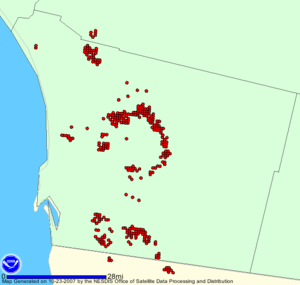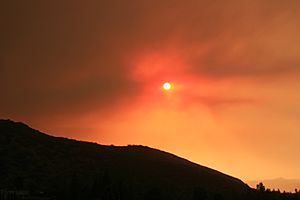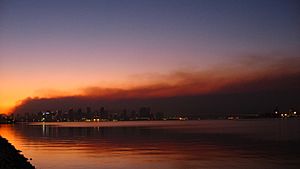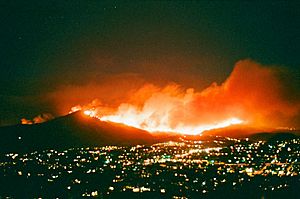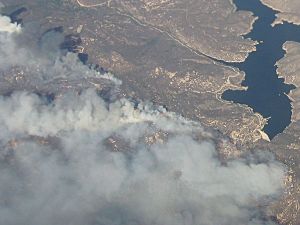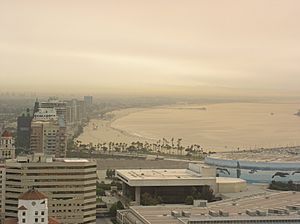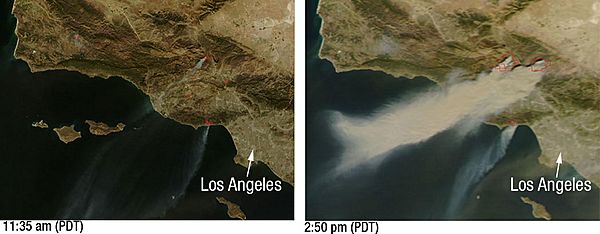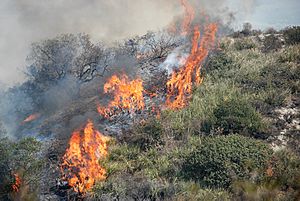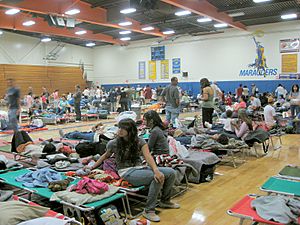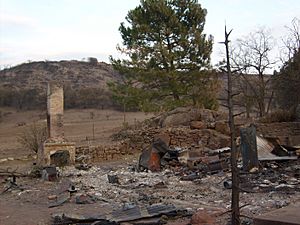October 2007 California wildfires facts for kids
Quick facts for kids October 2007 California wildfires |
|
|---|---|

NASA satellite photo (provided by NSPO, Taiwan National Space Organization) from October 22, 2007, showing the active fire zones and smoke plumes.
|
|
| Location | Southern California |
| Statistics | |
| Total fires | 30 |
| Cost | At least $2.393 billion (2007 USD) |
| Date(s) | October 20, 2007 – November 16, 2007 |
| Burned area | 972,147 acres (3,900 km2) |
| Cause | Human; downed power lines; heat; vehicle fires, etc. |
| Land use | Mixed, residential, and wildlands |
| Buildings destroyed | 3,143 |
| Deaths | 17 |
| Non-fatal injuries | At least 160 |
The October 2007 California wildfires, also known as the Fall 2007 California firestorm, were a group of about 30 wildfires that started burning across Southern California on October 20, 2007. These fires destroyed over 1,500 homes and burned about 972,147 acres (which is about 3,934 square kilometers) of land. This area stretched from Santa Barbara County all the way to the United States–Mexico border.
Sadly, 14 people lost their lives, with 9 of those deaths directly caused by the fires. Around 160 people were hurt, including over 120 firefighters. At their worst, these huge fires were even visible from space!
California Governor Arnold Schwarzenegger declared a state of emergency in seven counties where fires were burning. President George W. Bush also stepped in, ordering federal help for the state and local teams. More than 6,000 firefighters worked hard to battle the blazes. They were helped by the United States Armed Forces, the United States National Guard, and even 60 firefighters from Mexico.
These fires forced about 1,000,000 people to leave their homes, making it the biggest evacuation in California's history at the time.
The fires spread quickly because of several things:
- A long period of drought in Southern California.
- Very hot weather.
- Unusually strong Santa Ana winds, which are dry, hot winds that can blow very fast. Gusts reached up to 85 miles per hour (140 km/h)!
California's "fire season" used to be from June to October, but now fires can happen all year. This is due to ongoing drought and more homes being built in areas surrounded by dry brush and forests.
The fires started in many ways. Some were caused by power lines that fell because of the strong winds. One fire began when a semi-truck overturned. Another fire was thought to be started on purpose. The Buckweed Fire was accidentally started by a 10-year-old boy playing with matches. The very last active fire, called the Harris Fire, was finally put out on November 16, 2007, about 27 days after the first fires began. The October 2007 wildfires caused over $2 billion in damage to insured properties.
Contents
Major Fires in 2007
This section lists the main fires that were part of the October 2007 California firestorm. Many of these wildfires were managed by Cal Fire.
| Name | County | Acres | Km2 | Start Date | Contained Date | Notes |
|---|---|---|---|---|---|---|
| Ranch | Los Angeles | 58,401 | 236.3 | October 20, 2007 | October 30, 2007 | 10 structures destroyed |
| Canyon | Los Angeles | 4,521 | 18.3 | October 21, 2007 | October 27, 2007 | 8 structures destroyed |
| Sedgewick Fire | Santa Barbara | 710 | 2.9 | October 21, 2007 | October 30, 2007 | |
| Harris | San Diego | 90,440 | 366.0 | October 21, 2007 | November 5, 2007 | 472 structures destroyed, 1 civilian fatality |
| October Fire | Los Angeles | 35 | 0.1 | October 21, 2007 | October 30, 2007 | |
| Nightsky Fire | Ventura | 20 | 0.1 | October 21, 2007 | November 1, 2007 | |
| Witch | San Diego | 197,990 | 801.2 | October 21, 2007 | November 6, 2007 | 1,650 structures destroyed, 2 civilian fatalities |
| McCoy Fire | San Diego | 400 | 1.6 | October 21, 2007 | October 26, 2007 | 1 structure destroyed |
| Buckweed | Los Angeles | 38,356 | 155.2 | October 21, 2007 | November 1, 2007 | 63 structures destroyed |
| Roca Fire | Riverside | 270 | 1.1 | October 21, 2007 | November 1, 2007 | |
| Santiago | Orange | 28,400 | 114.9 | October 21, 2007 | November 9, 2007 | 24 structures destroyed |
| Coronado Hills Fire | San Diego | 250 | 1.0 | October 22, 2007 | October 30, 2007 | |
| Little Mountain Fire | San Bernardino | 650 | 2.6 | October 22, 2007 | October 24, 2007 | |
| Walker Fire | San Bernardino | 160 | 0.6 | October 22, 2007 | October 30, 2007 | |
| Cajon Fire | San Bernardino | 250 | 1.0 | October 22, 2007 | October 30, 2007 | |
| Magic | Los Angeles | 2,824 | 11.4 | October 22, 2007 | October 27, 2007 | |
| Slide | San Bernardino | 12,759 | 51.6 | October 22, 2007 | October 31, 2007 | 272 structures destroyed |
| Rice | San Diego | 9,472 | 38.3 | October 22, 2007 | November 1, 2007 | 248 structures destroyed |
| Grass Valley | San Bernardino | 1,247 | 5.0 | October 22, 2007 | October 29, 2007 | 178 structures destroyed |
| Rosa Fire | Riverside | 411 | 1.7 | October 22, 2007 | October 31, 2007 | |
| San Martin Fire | San Bernardino | 123 | 0.5 | October 23, 2007 | October 30, 2007 | |
| Meadowridge Fire | Los Angeles | 58,401 | 236.3 | October 23, 2007 | October 30, 2007 | |
| Poomacha | San Diego | 49,410 | 200.0 | October 23, 2007 | November 13, 2007 | 217 structures destroyed |
| Ammo (Horno) Fire | San Diego | 21,004 | 85.0 | October 23, 2007 | October 29, 2007 | |
| Wilcox Fire | San Diego | 100 | 0.4 | October 23, 2007 | October 26, 2007 | |
| Wildomar Fire | Riverside | 20 | 0.1 | October 24, 2007 | October 24, 2007 |
Fires by County
San Diego County Fires
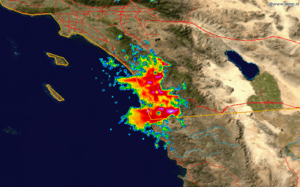
Two of the biggest wildfires were in San Diego County. The largest was the Witch Creek Fire, which burned areas in northern San Diego County. The second largest was the Harris Fire, which burned from the U.S.–Mexico border towards San Diego. Officials were worried these fires could be even worse than the 2003 Cedar Fire, which burned a huge area and destroyed many homes.
Many people had to leave their homes, either because it was required or suggested. Hundreds of thousands of residents got calls from a special phone system called Reverse 911. This system mostly worked well. On October 24, 2007, the San Diego County Sheriff said that more people were evacuated in San Diego County than during Hurricane Katrina in New Orleans.
About 500,000 people from at least 346,000 homes were told to evacuate. This was the largest evacuation in the region's history. People found shelter at places like Qualcomm Stadium, schools, community centers, and churches. The American Red Cross helped manage these shelters.
At Qualcomm Stadium, about 12,000 people gathered. Volunteers gave them food, blankets, water, internet access, toys for kids, and even live music. Most schools and universities in San Diego closed. Many businesses also closed. To keep roads clear for emergency vehicles, San Diego mayor Jerry Sanders asked everyone to stay home.
By October 23, some people were allowed to go back home. This included about 50,000 residents from cities like Del Mar, Chula Vista, and Poway. However, the fires continued to cause serious damage. The four main fires in San Diego County burned over 368,000 acres and destroyed or damaged 1,350 homes and 100 businesses by October 21, 2007.
Many major roads were closed because of the fires and smoke. For example, Interstate 15 was closed in both directions. Later, the Ammo (Horno) Fire closed Interstate 5 and even stopped train service.
Officials at the San Diego Wild Animal Park said their more than 3,500 animals were safe. The park had fire breaks and watered areas to protect them. Some critically endangered animals, like the California condor, were moved to the park's fire-resistant veterinary hospital.
Here is a summary of the fires in San Diego County:
| Fire name | Date / time started | Area burned | Structures destroyed | Injuries | Containment Date |
|---|---|---|---|---|---|
| Witch (Creek) | October 21 at 11:00 a.m. | 197,990 acres (801 km2) | 1,125 homes 509 outbuildings 239 vehicles 77 homes damaged 25 outbuildings damaged |
2 deaths 40 firefighters 2 civilians |
November 6 |
| Harris | October 21 at 9:23 a.m. | 90,440 acres (366 km2) | 206 homes 293 outbuildings 253 homes 2 commercial properties 12 homes damaged 3 outbuildings damaged |
5 deaths 40 firefighters 21 civilians |
|
| Poomacha (Palomar Mountain/Valley Center) | October 23 at 3:13 p.m. | 50,176 acres (203.06 km2) | 143 homes 77 outbuildings |
21 firefighters | |
| Horno/Ammo | October 23 at 9:20 p.m. | 21,084 acres (85.32 km2) (Ammo Fire) 6,000 acres (24.28 km2) (Horno Fire) |
6 firefighters | ||
| Rice | October 22 at 4:16 p.m. | 9,472 acres (38.3 km2) | 206 homes 2 commercial properties 40 outbuildings |
5 firefighters | |
| McCoy | October 21 | 400 acres (1.62 km2) | 1 residence 1 outbuilding |
||
| Coronado Hills | October 22 at 1:50 a.m. | 250 acres (1.01 km2) | 2 outbuildings | October 22 | |
| Wilcox | October 23 | 100 acres (0.40 km2) |
Witch Creek Fire Details
The Witch Creek Fire was the biggest of the October 2007 wildfires. It became the third-largest fire in California's history at the time. Many people were told to evacuate using the Reverse 911 system. This fire happened almost exactly four years after the Cedar Fire of 2003.
The fire began in Witch Creek Canyon and quickly spread to nearby towns like Ramona and Poway. Winds were so strong that they were reported to be over 100 miles per hour! The fire even jumped over Interstate 15, causing a lot of damage in areas like Rancho Santa Fe.
Strong Santa Ana winds pushed the fires west towards the coast. Fire officials reported flames that were 80 to 100 feet high! While many coastal towns were evacuated, the changing winds kept the fire from directly hitting those areas.
On October 22, residents in certain areas were ordered to evacuate. By that evening, the city of Del Mar strongly advised all its residents to leave. Evacuations were also ordered for parts of Scripps Ranch. The Mesa Grande Indian Reservation was evacuated, and people on the Barona Indian Reservation were advised to leave. The casino there closed.
Evacuation sites in San Diego County included Qualcomm Stadium, several high schools, and the Del Mar Fairgrounds.
Many major roads were closed. Interstate 15 was closed in both directions. Later, the Ammo (Horno) Fire closed Interstate 5, stopping train service as well. About 1,841 firefighters worked on this fire.
By October 24, some evacuation orders were lifted for areas like Rancho Bernardo. The Witch Creek Fire became 45% contained. On October 25, the Witch Fire joined with the nearby Poomacha Fire, forming one giant fire. The next day, it also merged with the smaller, already contained McCoy Fire.
Harris Fire Details
The Harris Fire started in Potrero, in southern San Diego County, close to Tecate, Mexico. It burned northwest, approaching eastern Chula Vista.
Many communities were evacuated, and shelters were set up at a high school and community center.
Sadly, Thomas James Varshock, 52, died on his property during the Harris Fire. His teenage son and four firefighters were injured trying to save them. This fire may also have caused the deaths of four migrant workers near the U.S.–Mexico border. About 1,210 firefighters battled this blaze.
The Harris Fire also spread into northern Mexico, near Tecate. On November 5, the Harris Fire was 100% contained. However, small hot spots continued to burn until November 16, when the very last one was put out.
Other San Diego County Fires
- Marine Corps Base Camp Pendleton Fires:
* The Wilcox Fire started behind Marine Corps Air Station Camp Pendleton. * The Ammo Fire was near the Las Pulgas/43 Area. * The Horno Fire burned 21,084 acres (85.32 km²) and was also in the Basilone Road area.
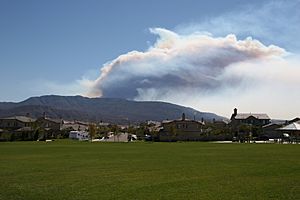
- Poomacha Fire: This fire began as a building fire on the La Jolla Indian Reservation. It then spread to Palomar Mountain and later joined with the Witch Fire. Because it was in steep terrain, it kept burning even after other fires were out, finally being fully contained on November 13, 2007.
- Rice Canyon Fire: This fire started early on October 22 near Fallbrook. It caused many evacuations and closed Interstate 15. The Rice Canyon Fire was caused by downed power lines.
- Coronado Hills Fire: This fire started near San Marcos.
- El Capitan Fire: On October 23, a small brush fire near El Capitan Reservoir was put out. It burned the plants near the reservoir and then ran out of fuel.
- McCoy Fire: This fire started on October 21 in the Cleveland National Forest. It burned 400 acres (1.6 km²) and destroyed at least one building. Although it was contained on October 23, the McCoy Fire later merged with the Witch Creek Fire.
Los Angeles and Ventura County Fires
Many fires burned in Los Angeles and Ventura Counties.
- Buckweed Fire: This fire burned north of Santa Clarita in Agua Dulce. It caused many evacuations. This fire was started by a child playing with matches.
- Canyon Fire: This fire burned around Malibu, California, especially in Malibu Canyon. It was one of the first fires to get a lot of attention from national news. Besides damaging or destroying 14 homes, it also destroyed two famous Malibu places: Castle Kashan and the Presbyterian Church.
- Magic Fire: This fire started near the Six Flags Magic Mountain theme park in Santa Clarita. Flames came very close to West Ranch High School and a large neighborhood, but were pushed away. It's believed to have been accidentally caused by welders at a construction site.
- Meadowridge Fire: This fire began near Highway 14 in Santa Clarita.

- October Fire: This fire burned a small area in Santa Clarita, damaging several mobile homes.
- Ranch Fire (Castaic / Piru): This fire burned along the Los Angeles-Ventura county line, about 5 miles (8 km) north of Santa Clarita. It surrounded the town of Piru and also threatened Fillmore and Ojai. About 500 homes were in the fire's path. Evacuations were suggested for all of Piru and parts of Fillmore.
- Nightsky Fire: This fire burned a small area south of Moorpark in Ventura County.
Here is a summary of the fires in Los Angeles and Ventura counties:
| Fire Name | Date / Time Started | Area Burned | Structures Destroyed | Injuries | Containment Date |
|---|---|---|---|---|---|
| Ranch (Castaic / Piru) | October 20 at 9:42 p.m. | 58,401 acres (236.3 km2) | 1 home 9 outbuildings |
||
| Buckweed | October 21 at 12:55 p.m. | 38,356 acres (155.2 km2) | 63 | 3 civilians 1 firefighter |
|
| Canyon | October 21 at 4:50 a.m. | 4,565 acres (18.5 km2) | 22 | 3 | |
| Magic | October 22 at 2:17 p.m. | 2,824 acres (11.4 km2) | |||
| Meadowridge | October 23 at 4:08 a.m. | 40 acres (0.162 km2) | |||
| Nightsky | October 21 at 10:35 a.m. | 35 acres (0.1 km2) | |||
| October | October 21 at 9:47 a.m. | 25 acres (0.1 km2) | At least 3 mobile homes damaged | October 30 |
Orange County Fires
- Santiago Fire: This fire started shortly before 5:55 p.m. on October 21, 2007, in the hills north of Irvine in Orange County. Fire officials believe it was started on purpose. On October 24, 2007, Governor Arnold Schwarzenegger visited a shelter for people who had to evacuate. Schools in Orange County closed on October 26 because of the smoke and bad air quality. A reward of $250,000 was offered for information to help catch whoever started the fire. This fire destroyed 14 homes and 24 other buildings, and 16 firefighters were injured. In total, it burned 28,445 acres (115.11 km²).
San Bernardino County Fires
Here is a summary of the fires in San Bernardino County:
| Fire Name | Date / Time Started | Area Burned | Structures Destroyed | Injuries | Containment Date |
|---|---|---|---|---|---|
| Slide (Running Springs) | October 22 at 8:02 a.m. | 12,789 acres (51.8 km2) | 201 homes 3 outbuildings |
||
| Grass Valley | October 22 at 5:08 p.m. | 1,247 acres (5.0 km2) | 174 homes 2 outbuildings |
||
| Martin Ranch | October 23 at 1:03 a.m. | 123 acres (0.5 km2) | 1 home damaged | 1 firefighter | |
| Walker | October 22 at 10:00 a.m. | 160 acres (0.6 km2) | 2 firefighters | Oct. 27 | |
| Cajon (Devore & Glen Helen) | October 22 at 11:48 a.m. | 250 acres (1.0 km2) | |||
| Little Mountain Fire | October 22 at 3:30 p.m. | 650 acres (2.6 km2) | October 22 |
- Slide Fire: This fire burned near Green Valley Lake, east of Lake Arrowhead. The towns of Green Valley Lake, Arrowbear, and Running Springs were evacuated. Over 1,300 firefighters worked on this fire. It partly burned "Camp Helendade," a camp owned by the Boy Scouts of America.
- Grass Valley Fire: This fire was located just north of Lake Arrowhead.
- Cajon Fire (Devore & Glen Helen): These fires together forced the closure of Interstate 15 in the Cajon Pass. One fire started when a semi-truck overturned.
- Little Mountain Fire: This fire threatened homes and buildings near Cal State San Bernardino before it was stopped. The university closed for a week because of the fires in the area.
Santa Barbara County Fires
- Sedgewick Fire: This was the northernmost of the October 2007 California wildfires. It started around 6:00 a.m. on October 21, 2007, from a fallen power line. The fire burned 710 acres (2.9 km²) near Los Olivos. About 2,000 people were affected, and 800 homes were in danger before the fire was fully contained on October 22.
Riverside County Fires
- Roca Fire: This fire was reported around 3:52 p.m. on October 21 near Aguanga. One home was destroyed, and one person was injured. It was 100% contained on October 22, after burning 270 acres (1.1 km²).
- Rosa Fire: This fire, actually three fires close together, started on October 22 in western Temecula. It was fully contained by October 24, after burning 411 acres (1.66 km²). Investigators suspect it was started on purpose.
- Wildomar Fire: This fire began around 12:30 p.m. on October 24 in Wildomar. It was 100% contained on the same day, after burning 20 acres (0.081 km²).
Baja California Fires
Fires also burned in northern parts of the Mexican state of Baja California. The Harris Fire burned near Tecate, and other fires burned near Tijuana.
More than 15,000 hectares (about 37,000 acres) were burned by wildfires in Baja California. Tijuana, Tecate, and Ensenada were the areas most affected. There were seven fires in total, all caused by the Santa Ana winds.
Wind and Weather Conditions

The fires happened at the end of a very dry summer. They were made much worse by the strong, seasonal Santa Ana winds. These winds were blowing much faster than usual. The San Diego Union-Tribune reported that "Santa Ana winds blowing up to 60 miles per hour (97 km/h) combined with temperatures into the 90s to create the worst possible fire conditions." At one point, swirling winds threatened to bring fire into busy city areas. On October 22, the Santa Ana winds reached steady speeds of 90 mph (140 km/h), with gusts up to 112 mph (180 km/h)!
Southern California was also going through a very unusual drought. In Los Angeles, California, it was the driest year on record. The mix of strong winds, heat, and dry conditions turned the chaparral plants into perfect fuel for the fires. Officials thought that some of the fires were so big they created their own winds, similar to the Oakland firestorm of 1991. The very fast Santa Ana winds also made it hard for firefighting planes to drop water effectively. The wind would scatter the water over such a large area that it would evaporate before reaching the fire.

Impact of the Fires
On October 21, the Harris Fire damaged a major power line that brings electricity from Arizona to San Diego. This caused Power outages for 333,500 customers in Los Angeles, Orange, San Diego, and other counties. Most power was back on within 24 hours. The power outage also affected many other cities. Mexico even provided electricity to help San Diego during the crisis.
Authorities said that the evacuation of over 900,000 people was the largest in California's history. By the morning of October 22, thousands of people had found shelter at Qualcomm Stadium and other places. The Marines moved some planes from Marine Corps Air Station Miramar to other military bases for safety. The Navy moved non-essential personnel from Naval Base San Diego barracks onto nearby ships to make room for people who needed shelter. The San Diego Wild Animal Park moved some animals to its on-site animal hospital for protection.
The Horno Fire burned 6,000 acres (24 km²) at Camp Pendleton. It closed Interstate 5 and stopped train service between Oceanside and San Clemente. Traffic was sent to Interstate 15, which had reopened.
Air Quality and Health Concerns
The fires caused the air to become very unhealthy due to tiny particles (called PM10) in the smoke. These particles are small enough to get deep into the lungs. San Diego city attorney Michael Aguirre suggested that the entire city consider a voluntary evacuation because of the bad air quality and weather.
See also
 In Spanish: Incendios forestales en California de octubre de 2007 para niños
In Spanish: Incendios forestales en California de octubre de 2007 para niños
- Witch Fire
- Recloser
- Corral Fire (2007)
- 2003 California wildfires
- 2008 California wildfires
- May 2014 San Diego County wildfires
- 2017 California wildfires
- October 2017 Northern California wildfires
- December 2017 Southern California wildfires
- List of California wildfires
- Pacific Gas and Electric
- San Diego Gas and Electric
- Wildfires in California-related topics
- FIRESCOPE


